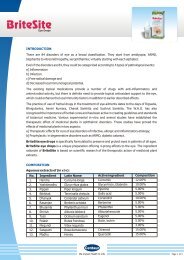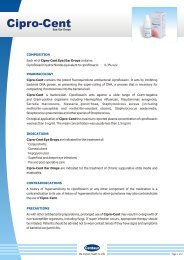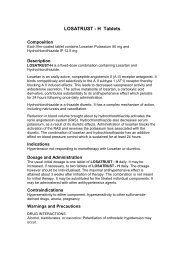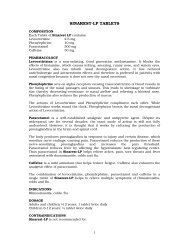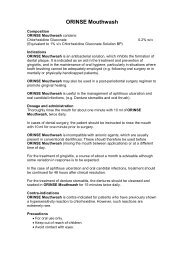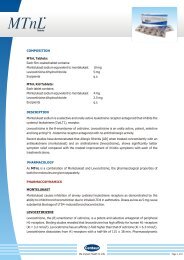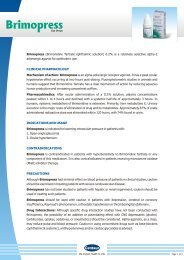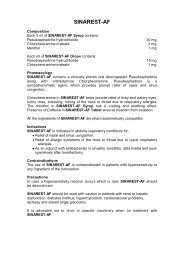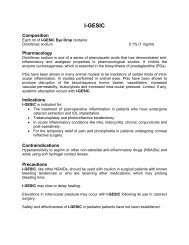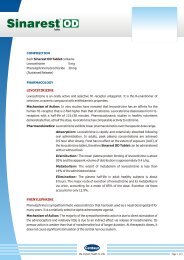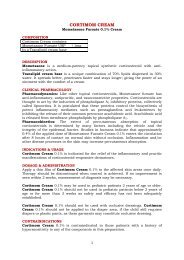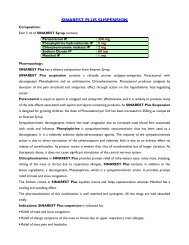Pilopress Eye Drops
Pilopress Eye Drops
Pilopress Eye Drops
Create successful ePaper yourself
Turn your PDF publications into a flip-book with our unique Google optimized e-Paper software.
DESCRIPTION<strong>Pilopress</strong> 2% [Pilocarpine nitrate Ophthalmic Solution] contains pilocarpine nitrate a parasympathomimeticdrug. Pilocarpine nitrate is a sterile ophthalmic solution, which is odourlessand colourless.Pilocarpine nitrate has a molecular formula of: Cl H N 0 .HN0 and molecular Weight of: 271.27.1 16 2 2 3The structural formula of Pilocarpine nitrate is:COMPOSITIONPilocarpine Nitrate IPChlorbutol IP[as preservative]Sterile buffered base2% w/vO.5% w/vq.s.CLINICAL PHARMACOLOGYMechanism of Action: Pilocarpine nitrate directly stimulates cholinergic receptors.It produces:- Contraction of the iris sphincter muscle, resulting in pupillaryconstriction (miosis)- Constriction of the ciliary muscle, resulting in increased accommodation- Reduction in intraocular pressure associated with an increase in theoutflow and a decrease in the inflow of aqueous humour.In chronic open angle glaucoma, the exact mechanism by which mioticslower intraocular pressure is not precisely known. However, contraction ofthe ciliary muscle apparently opens the intertrabecular spaces andfacilitates aqueous humour outflow. There is also a decrease in the rate ofinflow of aqueous humour. In angle-closure glaucoma, constriction of thepupil apparently pulls the iris away from the trabeculum, thereby relievingblockage of the trabecular meshwork.Pharmacokinetics:Miosis (pupillary constriction) occurs within 10 to 30 minutes and lasts4 to 8 hours. Intraocular pressure starts decreasing within 75 minutes andpersists for 4 to 6 hours.Page 1 of 3
Following systemic absorption pilocarpine undergoes biotransformationwhich is thought to occur at the neural synapses and in the plasma.Elimination occurs in the urine, as unchanged pilocarpine and itsminimally active or inactive degradation products, such as pilocarpic acid.INDICATIONSPilocarpine nitrate is used to constrict the pupil, to counteract the effect of mydriatic drugs such asatropine and phenylephrine and to decrease the intraocular pressure in the treatment of openangleglaucoma and closed-angle glaucoma and detachment of the retina. As a miotic, it is onlyabout half as active as physostigmine, and its action is less complete and of shorter duration.DOSAGE & ADMINISTRATIONUsually 1 or 2 drops of <strong>Pilopress</strong> 2% [Pilocarpine nitrate Ophthalmic Solution] should be instilledin the affected eyes] two to four times a day.CONTRAINDICATIONS- Hypersensitivity to any ingredient including excipients.- Conditions where pupillary constriction is undesirable (e.g. acute iritis).- Retinal detachment, past history of retinal detachment or conditions that predispose toretinal detachment.WARNINGSIf blurred vision or changes in near or far sight occur, especially at night, patients should exercisecaution when involved in night driving or hazardous work in poor light.It is recommended that intraocular pressure measurements be performed regularly during therapy.For patients who suffer from bronchial asthma, the risk/benefit should be weighed beforeprescribing.To minimise systemic absorption of the active ingredient of these eye drops, pressure should beapplied for one minute on the tear duct after application. Hands should be washed immediatelyafter use of the drops to remove traces of the medication from the fingers.The drops should be discarded no later than 4 weeks after first opening the container.Pregnancy: There are no adequate and well-controlled studies in pregnant women.<strong>Pilopress</strong> 2% [Pilocarpine nitrate Ophthalmic Solution] should be used during pregnancy only ifthe potential benefit justifies the potential risk to the fetus.Lactation: Pilocarpine nitrate has been detected in human milk following ophthalmic drugadministration. Because of the potential for serious adverse reactions from <strong>Pilopress</strong> 2%[Pilocarpine nitrate Ophthalmic Solution] in nursing infants, a decision should be made whether todiscontinue nursing or to discontinue the drug, taking into account the importance of the drug tothe mother.Pediatric Use: Appropriate studies on the effects of paediatric dosage have not been performed.However, no paediatric-specific problems have been documented to date.Carcinogenicity, Mutagenicity: No definitive long term animal studies have evaluated thecarcinogenic potential of pilocarpine hydrochloride.Page 2 of 3
DRUG INTERACTIONSBelladonna alkaloids or cyclopentolate used ophthalmically may interfere with the miotic effects ofpilocarpine and may have their own mydriatic effects dampened. This latter may be used totherapeutic advantage.ADVERSE REACTIONS- The most frequent adverse effects upon instillation of <strong>Pilopress</strong> 2% [Pilocarpine nitrateOphthalmic Solution] are: temporary blurred vision, burning, stinging, redness or watering of theeyes, decrease in night vision, eye irritation, headache or browache.- Less frequent to rare: eye pain- Adverse reactions associated with systemic absorption include: increased sweating, muscletremors, nausea, vomiting, diarrhoea, watering of the mouth, difficulty in breathing or wheezingOVERDOSAGEDilution with water and other fluids IS the usual response to accidental or deliberate overdose.PRESENTATION<strong>Pilopress</strong> 2% [Pilocarpine nitrate Ophthalmic Solution]is available in Sml bottles.STORAGE- Store below 2SoC- Protect from light- Do not freezePage 3 of 3



